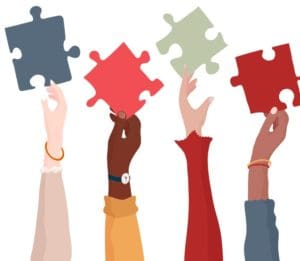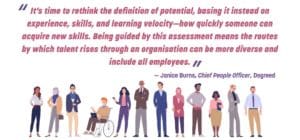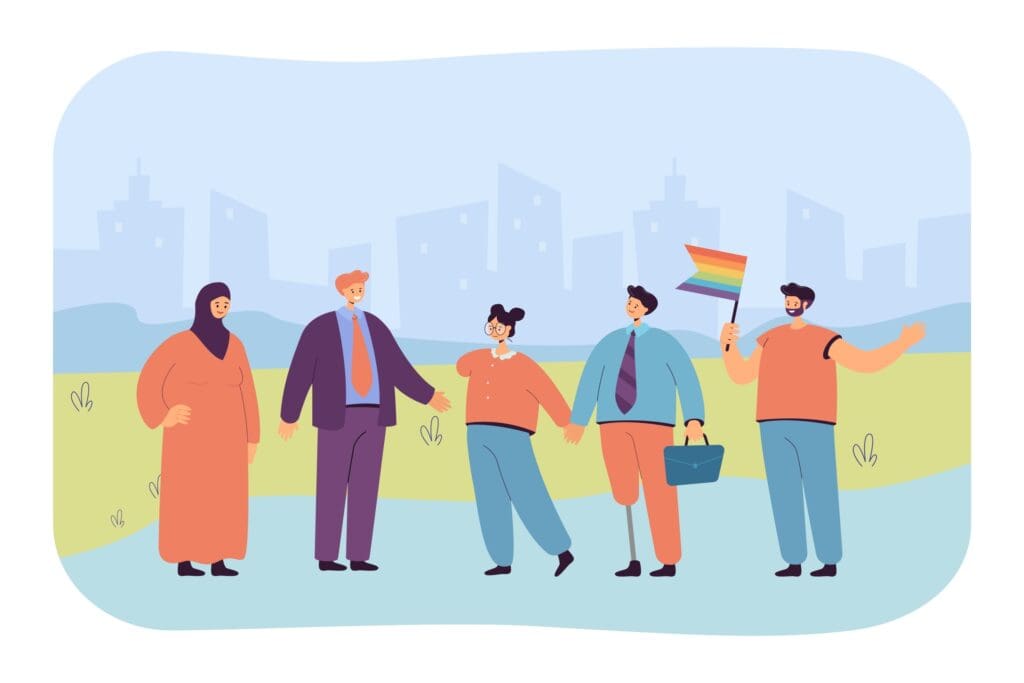Organisations are redefining what it means to be inclusive and that comes with expanding efforts to become truly equitable.
By Simon Kent
Mark Dickinson-Keen, chief people officer for M&C Saatchi Group, has no hesitation in emphasising the need for his business to employ, retain, and develop people from diverse socio-economic backgrounds. Without a diverse workforce, the company will not have the right perspectives to produce advertising material that will appeal to a diverse audience. He gives an example. “We were working with the Department for Education on promoting apprenticeship schemes,” he explains. “There’s no way we can do that with any credibility unless the team includes someone who’s actually doing an apprenticeship.”
Sona Sherratt, professor of practice for psychological safety, inclusive leadership, and learning agility at Hult International Business School, believes the issue of social mobility is sometimes not given the same emphasis as other aspects of diversity. “People from lower socio-economic groups are either omitted altogether, included as a token gesture, or contained as contributors -not leaders -in society in the twentieth century,” she says. But enhancing inclusion in the workplace will always pay dividends, as she says many studies have shown how respect and social connections within a group yield a greater contribution towards a common goal.
Janice Burns, chief people officer of Degreed, advocates a skills-based approach to incorporate diversity within their organisation. “One of the most effective ways to drive diversity and inclusion is to look at the skills that build diverse and inclusive organisations at each employee level,” she explains. She points to research from RedThread Research which has identified skills across employee levels that teams can focus on to drive a stronger DEI culture.
- Individual employees: authenticity, courage, data literacy, pattern recognition, managing ambiguity, and the ability to empower people.
- Managers: curiosity, influence, negotiation, and grit.
- Senior leaders: mental flexibility, rapport-building, and assertiveness.
- Across all three groups: calculated risk-taking and nonverbal communication.
Burns emphasises that these skills aren’t learned in the classroom, but are developed through real-world experience. “The ability to empower people, for example, can be developed through taking part in a leadership role that is associated with a business resource group, participating as a coach in a peer coaching programme, or volunteering to lead a change initiative,” she says. “Influence might be built when someone practices public speaking or builds their personal brand online. Remember that skills are what you do and you can only get good at them by doing the work.”
However, getting the right skills is just one part of the puzzle. Without due care and attention, business culture can prove itself stacked against certain members of the workforce who may not show the “expected” performance levels more easily demonstrated by others. “The processes we have today are based on a model of performance and a definition of potential, which is usually an assessment of potential made on the knowledge that a leader or manager has of the person in question or the type of job they are performing,” suggests Burns. “So even if you have an employee with the experience and skills needed for a certain project or role, if they were not exposed to that particular leader or manager, they may not have the opportunity to get that position because they have not been identified as having high potential based on their lack of exposure.”
Burns says it’s time to rethink the definition of potential, basing it instead on experience, skills, and learning velocity (how quickly someone can acquire new skills). Being guided by this assessment means the routes by which talent rises through an organisation can be more diverse and include all employees.
At M&C Saatchi Group, an initiative called “Open House” effectively saw the business up-end their recruitment process in order to make the organisation more accessible to people of diverse backgrounds. Rather than selecting a shortlist from thousands of applicants to enter their training programme, the company put the training programme online and signed up thousands of participants. Outreach work helped to boost diversity further (35% ethnic minority participants, 40% from outside London) and included reaching people going through career transitions and those returning to the workplace. On completion, participants received a certificate of achievement and the chance to apply to the company.
 Along the way, some of M&C Saatchi Group’s senior staff who delivered the training were able to “talent spot” and offer diverse routes and opportunities where they found appropriate candidates. The company’s Talent Manager, Zoe Miller, also notes than even the follow-up application process was made as easy and unbiased as possible. “We did it CV blind, with no name, no education details or anything else,” she says. “We just asked them to answer one question, ‘What can you uniquely bring to the business?'”
Along the way, some of M&C Saatchi Group’s senior staff who delivered the training were able to “talent spot” and offer diverse routes and opportunities where they found appropriate candidates. The company’s Talent Manager, Zoe Miller, also notes than even the follow-up application process was made as easy and unbiased as possible. “We did it CV blind, with no name, no education details or anything else,” she says. “We just asked them to answer one question, ‘What can you uniquely bring to the business?'”
The company also ensured everyone concerned with selection went through unconscious bias training. Miller explains that very often the scheme doesn’t just identify newcomers to the industry, but also helps those in other industries to realise transferable skills or opportunities to upskill and take on a new role in advertising.
The company also takes part in a number of industry-wide initiatives including an annual “Open Doors” event where companies literally welcome anyone in to see what working in the industry means and whether there’s a role for them. There are also further initiatives to promote gender equity in the industry which involve mentorships and partnerships with other related organisations.
“The common thread, whether it’s speaking in school or doing something with multiple other partners, is that it’s all about opening up awareness of the industry and therefore diversifying the entrants,” says Dickinson-Keen. “We want real representation, and we want to hear different people’s voices. We actually have the phrase here that it is a creative necessity.”
The results of such efforts are not measured financially but rather in client satisfaction. An effective campaign is appreciated by everyone. More rewarding still, there is a trend among clients to positively seek out diverse teams to work with whenever they have an advertising need -a clear sign that an impact is being made.















